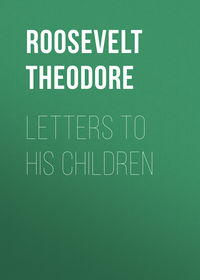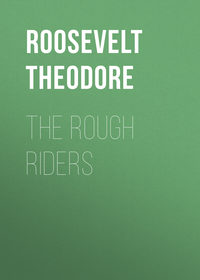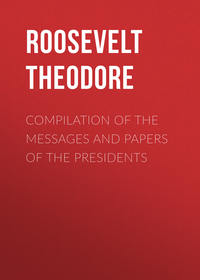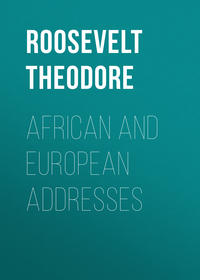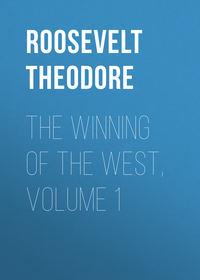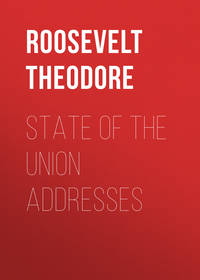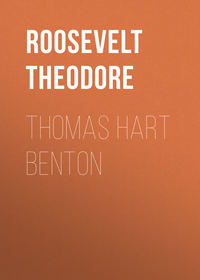 полная версия
полная версияThrough the Brazilian Wilderness
But the vital difference is that between all these poisons of the pit- vipers and the poisons of the colubrine snakes, such as the cobra and the coral-snake. As yet the doctor has not been able to develop an anti-venom serum which will neutralize the poison of these colubrine snakes. Practically this is a matter of little consequence in Brazil, for the Brazilian coral-snakes are dangerous only when mishandled by some one whose bare skin is exposed to the bite. The numerous accidents and fatalities continually occurring in Brazil are almost always to be laid to the account of the several species of lachecis and the single species of rattlesnake.
Finally, the doctor took us into his lecture-room to show us how he conducted his experiments. The various snakes were in boxes, on one side of the room, under the care of a skilful and impassive assistant, who handled them with the cool and fearless caution of the doctor himself. The poisonous ones were taken out by means of a long-handled steel hook. All that is necessary to do is to insert this under the snake and lift him off the ground. He is not only unable to escape, but he is unable to strike, for he cannot strike unless coiled so as to give himself support and leverage. The table on which the snakes are laid is fairly large and smooth, differing in no way from an ordinary table.
There were a number of us in the room, including two or three photographers. The doctor first put on the table a non-poisonous but very vicious and truculent colubrine snake. It struck right and left at us. Then the doctor picked it up, opened its mouth, and showed that it had no fangs, and handed it to me. I also opened its mouth and examined its teeth, and then put it down, whereupon, its temper having been much ruffled, it struck violently at me two or three times. In its action and temper this snake was quite as vicious as the most irritable poisonous snakes. Yet it is entirely harmless. One of the innumerable mysteries of nature which are at present absolutely insoluble is why some snakes should be so vicious and others absolutely placid and good-tempered.
After removing the vicious harmless snake, the doctor warned us to get away from the table, and his attendant put on it, in succession, a very big lachecis—of the kind called bushmaster—and a big rattlesnake. Each coiled menacingly, a formidable brute ready to attack anything that approached. Then the attendant adroitly dropped his iron crook on the neck of each in succession, seized it right behind the head, and held it toward the doctor. The snake's mouth was in each case wide open, and the great fangs erect and very evident. It would not have been possible to have held an African ring-necked cobra in such fashion, because the ring-neck would have ejected its venom through the fangs into the eyes of the onlookers. There was no danger in this case, and the doctor inserted a shallow glass saucer into the mouth of the snake behind the fangs, permitted it to eject its poison, and then himself squeezed out the remaining poison from the poison- bags through the fangs. From the big lachecis came a large quantity of yellow venom, a liquid which speedily crystallized into a number of minute crystals. The rattlesnake yielded a much less quantity of white venom, which the doctor assured us was far more active than the yellow lachecis venom. Then each snake was returned to its box unharmed.
After this the doctor took out of a box and presented to me a fine, handsome, nearly black snake, an individual of the species called the mussurama. This is in my eyes perhaps the most interesting serpent in the world. It is a big snake, four or five feet long, sometimes even longer, nearly black, lighter below, with a friendly, placid temper. It lives exclusively on other snakes, and is completely immune to the poison of the lachecis and rattlesnake groups, which contain all the really dangerous snakes of America. Doctor Brazil told me that he had conducted many experiments with this interesting snake. It is not very common, and prefers wet places in which to live. It lays eggs, and the female remains coiled above the eggs, the object being apparently not to warm them, but to prevent too great evaporation. It will not eat when moulting, nor in cold weather. Otherwise it will eat a small snake every five or six days, or a big one every fortnight.
There is the widest difference, both among poisonous and non-poisonous snakes, not alone in nervousness and irascibility but also in ability to accustom themselves to out-of-the-way surroundings. Many species of non-poisonous snakes which are entirely harmless, to man or to any other animal except their small prey, are nevertheless very vicious and truculent, striking right and left and biting freely on the smallest provocation—this is the case with the species of which the doctor had previously placed a specimen on the table. Moreover, many snakes, some entirely harmless and some vicious ones, are so nervous and uneasy that it is with the greatest difficulty they can be induced to eat in captivity, and the slightest disturbance or interference will prevent their eating. There are other snakes, however, of which the mussurama is perhaps the best example, which are very good captives, and at the same time very fearless, showing a complete indifference not only to being observed but to being handled when they are feeding.
There is in the United States a beautiful and attractive snake, the king-snake, with much the same habits as the mussurama. It is friendly toward mankind, and not poisonous, so that it can be handled freely. It feeds on other serpents, and will kill a rattlesnake as big as itself, being immune to the rattlesnake venom. Mr. Ditmars, of the Bronx Zoo, has made many interesting experiments with these king- snakes. I have had them in my own possession. They are good-natured and can generally be handled with impunity, but I have known them to bite, whereas Doctor Brazil informed me that it was almost impossible to make the mussurama bite a man. The king-snake will feed greedily on other snakes in the presence of man—I knew of one case where it partly swallowed another snake while both were in a small boy's pocket. It is immune to viper poison but it is not immune to colubrine poison. A couple of years ago I was informed of a case where one of these king-snakes was put into an enclosure with an Indian snake- eating cobra or hamadryad of about the same size. It killed the cobra but made no effort to swallow it, and very soon showed the effects of the cobra poison. I believe it afterward died, but unfortunately I have mislaid my notes and cannot now remember the details of the incident.
Doctor Brazil informed me that the mussurama, like the king-snake, was not immune to the colubrine poison. A mussurama in his possession, which had with impunity killed and eaten several rattlesnakes and representatives of the lachecis genus, also killed and ate a venomous coral-snake, but shortly afterward itself died from the effects of the poison. It is one of the many puzzles of nature that these American serpents which kill poisonous serpents should only have grown immune to the poison of the most dangerous American poisonous serpents, the pit-vipers, and should not have become immune to the poison of the coral-snakes which are commonly distributed throughout their range. Yet, judging by the one instance mentioned by Doctor Brazil, they attack and master these coral-snakes, although the conflict in the end results in their death. It would be interesting to find out whether this attack was exceptional, that is, whether the mussurama has or has not as a species learned to avoid the coral-snake. If it was not exceptional, then not only is the instance highly curious in itself, but it would also go far to explain the failure of the mussurama to become plentiful.
For the benefit of those who are not acquainted with the subject, I may mention that the poison of a poisonous snake is not dangerous to its own species unless injected in very large doses, about ten times what would normally be injected by a bite; but that it is deadly to all other snakes, poisonous or non-poisonous, save as regards the very few species which themselves eat poisonous snakes. The Indian hamadryad, or giant cobra, is exclusively a snake-eater. It evidently draws a sharp distinction between poisonous and non-poisonous snakes, for Mr. Ditmars has recorded that two individuals in the Bronx Zoo which are habitually fed on harmless snakes, and attack them eagerly, refused to attack a copperhead which was thrown into their cage, being evidently afraid of this pit-viper. It would be interesting to find out if the hamadryad is afraid to prey on all pit-vipers, and also whether it will prey on its small relative, the true cobra—for it may well be that, even if not immune to the viper poison, it is immune to the poison of its close ally, the smaller cobra.
All these and many other questions would be speedily settled by Doctor Brazil if he were given the opportunity to test them. It must be remembered, moreover, that not only have his researches been of absorbing value from the standpoint of pure science but that they also have a real utilitarian worth. He is now collecting and breeding the mussurama. The favorite prey of the mussurama is the most common and therefore the most dangerous poisonous snake of Brazil, the jararaca, which is known in Martinique as the fer-de-lance. In Martinique and elsewhere this snake is such an object of terror as to be at times a genuine scourge. Surely it would be worth while for the authorities of Martinique to import specimens of the mussurama to that island. The mortality from snake-bite in British India is very great. Surely it would be well worth while for the able Indian Government to copy Brazil and create such an institute as that over which Doctor Vital Brazil is the curator.
At first sight it seems extraordinary that poisonous serpents, so dreaded by and so irresistible to most animals, should be so utterly helpless before the few creatures that prey on them. But the explanation is easy. Any highly specialized creature, the higher its specialization, is apt to be proportionately helpless when once its peculiar specialized traits are effectively nullified by an opponent. This is eminently the case with the most dangerous poisonous snakes. In them a highly peculiar specialization has been carried to the highest point. They rely for attack and defence purely on their poison-fangs. All other means and methods of attack and defence have atrophied. They neither crush nor tear with their teeth nor constrict with their bodies. The poison-fangs are slender and delicate, and, save for the poison, the wound inflicted is of a trivial character. In consequence they are helpless in the presence of any animal which the poison does not affect. There are several mammals immune to snake- bite, including various species of hedgehog, pig, and mongoose—the other mammals which kill them do so by pouncing on them unawares or by avoiding their stroke through sheer quickness of movement; and probably this is the case with most snake-eating birds. The mongoose is very quick, but in some cases at least—I have mentioned one in the "African Game Trails"—it permits itself to be bitten by poisonous snakes, treating the bite with utter indifference. There should be extensive experiments made to determine if there are species of mongoose immune to both cobra and viper poison. Hedgehogs, as determined by actual experiments, pay no heed at all to viper poison even when bitten on such tender places as the tongue and lips and eat the snake as if it were a radish. Even among animals which are not immune to the poison different species are very differently affected by the different kinds of snake poisons. Not only are some species more resistant than others to all poisons, but there is a wide variation in the amount of immunity each displays to any given venom. One species will be quickly killed by the poison from one species of snake, and be fairly resistant to the poison of another; whereas in another species the conditions may be directly reversed.
The mussurama which Doctor Brazil handed me was a fine specimen, perhaps four and a half feet long. I lifted the smooth, lithe bulk in my hands, and then let it twist its coils so that it rested at ease in my arms; it glided to and fro, on its own length, with the sinuous grace of its kind, and showed not the slightest trace of either nervousness or bad temper. Meanwhile the doctor bade his attendant put on the table a big jararaca, or fer-de-lance, which was accordingly done. The jararaca was about three feet and a half, or perhaps nearly four feet long—that is, it was about nine inches shorter than the mussurama. The latter, which I continued to hold in my arms, behaved with friendly and impassive indifference, moving easily to and fro through my hands, and once or twice hiding its head between the sleeve and the body of my coat. The doctor was not quite sure how the mussurama would behave, for it had recently eaten a small snake, and unless hungry it pays no attention whatever to venomous snakes, even when they attack and bite it. However, it fortunately proved still to have a good appetite.
The jararaca was alert and vicious. It partly coiled itself on the table, threatening the bystanders. I put the big black serpent down on the table four or five feet from the enemy and headed in its direction. As soon as I let go with my hands it glided toward where the threatening, formidable-looking lance-head lay stretched in a half coil. The mussurama displayed not the slightest sign of excitement. Apparently it trusted little to its eyes, for it began to run its head along the body of the jararaca, darting out its flickering tongue to feel just where it was, as it nosed its way up toward the head of its antagonist. So placid were its actions that I did not at first suppose that it meant to attack, for there was not the slightest exhibition of anger or excitement.
It was the jararaca that began the fight. It showed no fear whatever of its foe, but its irritable temper was aroused by the proximity and actions of the other, and like a flash it drew back its head and struck, burying its fangs in the forward part of the mussurama's body. Immediately the latter struck in return, and the counter-attack was so instantaneous that it was difficult to see just what had happened. There was tremendous writhing and struggling on the part of the jararaca; and then, leaning over the knot into which the two serpents were twisted, I saw that the mussurama had seized the jararaca by the lower jaw, putting its own head completely into the wide-gaping mouth of the poisonous snake. The long fangs were just above the top of the mussurama's head; and it appeared, as well as I could see, that they were once again driven into the mussurama; but without the slightest effect. Then the fangs were curved back in the jaw, a fact which I particularly noted, and all effort at the offensive was abandoned by the poisonous snake.
Meanwhile the mussurama was chewing hard, and gradually shifted its grip, little by little, until it got the top of the head of the jararaca in its mouth, the lower jaw of the jararaca being spread out to one side. The venomous serpent was helpless; the fearsome master of the wild life of the forest, the deadly foe of humankind, was itself held in the grip of death. Its cold, baleful serpent's eyes shone, as evil as ever. But it was dying. In vain it writhed and struggled. Nothing availed it.
Once or twice the mussurama took a turn round the middle of the body of its opponent, but it did not seem to press hard, and apparently used its coils chiefly in order to get a better grip so as to crush the head of its antagonist, or to hold the latter in place. This crushing was done by its teeth; and the repeated bites were made with such effort that the muscles stood out on the mussurama's neck. Then it took two coils round the neck of the jararaca and proceeded deliberately to try to break the backbone of its opponent by twisting the head round. With this purpose it twisted its own head and neck round so that the lighter-colored surface was uppermost; and indeed at one time it looked as if it had made almost a complete single spiral revolution of its own body. It never for a moment relaxed its grip except to shift slightly the jaws.
In a few minutes the jararaca was dead, its head crushed in, although the body continued to move convulsively. When satisfied that its opponent was dead, the mussurama began to try to get the head in its mouth. This was a process of some difficulty on account of the angle at which the lower jaw of the jararaca stuck out. But finally the head was taken completely inside and then swallowed. After this, the mussurama proceeded deliberately, but with unbroken speed, to devour its opponent by the simple process of crawling outside it, the body and tail of the jararaca writhing and struggling until the last. During the early portion of the meal, the mussurama put a stop to this writhing and struggling by resting its own body on that of its prey; but toward the last the part of the body that remained outside was left free to wriggle as it wished.
Not only was the mussurama totally indifferent to our presence, but it was totally indifferent to being handled while the meal was going on. Several times I replaced the combatants in the middle of the table when they had writhed to the edge, and finally, when the photographers found that they could not get good pictures, I held the mussurama up against a white background with the partially swallowed snake in its mouth; and the feast went on uninterruptedly. I never saw cooler or more utterly unconcerned conduct; and the ease and certainty with which the terrible poisonous snake was mastered gave me the heartiest respect and liking for the easy-going, good-natured, and exceedingly efficient serpent which I had been holding in my arms.
Our trip was not intended as a hunting-trip but as a scientific expedition. Before starting on the trip itself, while travelling in the Argentine, I received certain pieces of first-hand information concerning the natural history of the jaguar, and of the cougar, or puma, which are worth recording. The facts about the jaguar are not new in the sense of casting new light on its character, although they are interesting; but the facts about the behavior of the puma in one district of Patagonia are of great interest, because they give an entirely new side of its life-history.
There was travelling with me at the time Doctor Francisco P. Moreno, of Buenos Aires. Doctor Moreno is at the present day a member of the National Board of Education of the Argentine, a man who has worked in every way for the benefit of his country, perhaps especially for the benefit of the children, so that when he was first introduced to me it was as the "Jacob Riis of the Argentine"—for they know my deep and affectionate intimacy with Jacob Riis. He is also an eminent man of science, who has done admirable work as a geologist and a geographer. At one period, in connection with his duties as a boundary commissioner on the survey between Chile and the Argentine, he worked for years in Patagonia. It was he who made the extraordinary discovery in a Patagonian cave of the still fresh fragments of skin and other remains of the mylodon, the aberrant horse known as the onohipidium, the huge South American tiger, and the macrauchenia, all of them extinct animals. This discovery showed that some of the strange representatives of the giant South American Pleistocene fauna had lasted down to within a comparatively few thousand years, down to the time when man, substantially as the Spaniards found him, flourished on the continent. Incidentally the discovery tended to show that this fauna had lasted much later in South America than was the case with the corresponding faunas in other parts of the world; and therefore it tended to disprove the claims advanced by Doctor Ameghino for the extreme age, geologically, of this fauna, and for the extreme antiquity of man on the American continent.
One day Doctor Moreno handed me a copy of The Outlook containing my account of a cougar-hunt in Arizona, saying that he noticed that I had very little faith in cougars attacking men, although I had explicitly stated that such attacks sometimes occurred. I told him, Yes, that I had found that the cougar was practically harmless to man, the undoubtedly authentic instances of attacks on men being so exceptional that they could in practice be wholly disregarded. Thereupon Doctor Moreno showed me a scar on his face, and told me that he had himself been attacked and badly mauled by a puma which was undoubtedly trying to prey on him; that is, which had started on a career as a man-eater. This was to me most interesting. I had often met men who knew other men who had seen other men who said that they had been attacked by pumas, but this was the first time that I had ever come across a man who had himself been attacked. Doctor Moreno, as I have said, is not only an eminent citizen, but an eminent scientific man, and his account of what occurred is unquestionably a scientifically accurate statement of the facts. I give it exactly as the doctor told it; paraphrasing a letter he sent me, and including one or two answers to questions I put to him. The doctor, by the way, stated to me that he had known Mr. Hudson, the author of the "Naturalist on the Plata," and that the latter knew nothing whatever of pumas from personal experience and had accepted as facts utterly wild fables.
Undoubtedly, said the doctor, the puma in South America, like the puma in North America, is, as a general rule, a cowardly animal which not only never attacks man, but rarely makes any efficient defence when attacked. The Indian and white hunters have no fear of it in most parts of the country, and its harmlessness to man is proverbial. But there is one particular spot in southern Patagonia where cougars, to the doctor's own personal knowledge, have for years been dangerous foes of man. This curious local change in habits, by the way, is nothing unprecedented as regards wild animals. In portions of its range, as I am informed by Mr. Lord Smith, the Asiatic tiger can hardly be forced to fight man, and never preys on him, while throughout most of its range it is a most dangerous beast, and often turns man-eater. So there are waters in which sharks are habitual man- eaters, and others where they never touch men; and there are rivers and lakes where crocodiles or caymans are very dangerous, and others where they are practically harmless—I have myself seen this in Africa.
In March, 1877, Doctor Moreno with a party of men working on the boundary commission, and with a number of Patagonian horse-Indians, was encamped for some weeks beside Lake Viedma, which had not before been visited by white men for a century, and which was rarely visited even by Indians. One morning, just before sunrise, he left his camp by the south shore of the lake, to make a topographical sketch of the lake. He was unarmed, but carried a prismatic compass in a leather case with a strap. It was cold, and he wrapped his poncho of guanaco- hide round his neck and head. He had walked a few hundred yards, when a puma, a female, sprang on him from behind and knocked him down. As she sprang on him she tried to seize his head with one paw, striking him on the shoulder with the other. She lacerated his mouth and also his back, but tumbled over with him, and in the scuffle they separated before she could bite him. He sprang to his feet, and, as he said, was forced to think quickly. She had recovered herself, and sat on her haunches like a cat, looking at him, and then crouched to spring again; whereupon he whipped off his poncho, and as she sprang at him he opened it, and at the same moment hit her head with the prismatic compass in its case which he held by the strap. She struck the poncho and was evidently puzzled by it, for, turning, she slunk off to one side, under a bush, and then proceeded to try to get round behind him. He faced her, keeping his eyes upon her, and backed off. She followed him for three or four hundred yards. At least twice she came up to attack him, but each time he opened his poncho and yelled, and at the last moment she shrank back. She continually, however, tried, by taking advantage of cover, to sneak up to one side, or behind, to attack him. Finally, when he got near camp, she abandoned the pursuit and went into a small patch of bushes. He raised the alarm; an Indian rode up and set fire to the bushes from the windward side. When the cougar broke from the bushes, the Indian rode after her, and threw his bolas, which twisted around her hind legs; and while she was struggling to free herself, he brained her with his second bolas. The doctor's injuries were rather painful, but not serious.


